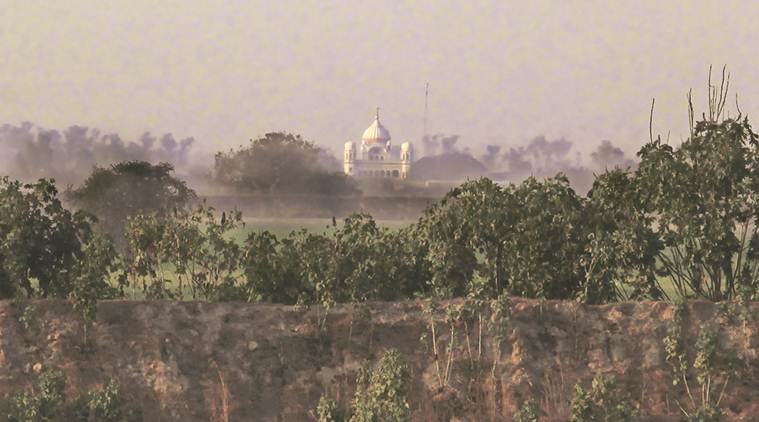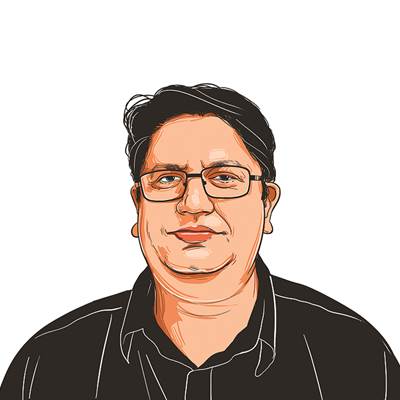The pilgrims’ long route
As hopes for a corridor dim, road to Gurdwara Darbar Sahib must pass through Lahore

Three years ago, standing in the relatively empty gurdwara complex inside Pakistan, the Indian border seemed within touching distance. (In pic: Gurdwara Kartarpur Sahib, seen from the Indian side)
Had Gurdaspur district not been awarded to India by the Radcliffe Award, the angst of losing Gurdwara Darbar Sahib in Kartarpur would perhaps have been less since it would have been located deep inside Pakistan. Now, it is barely a few km away as the crow flies, and visible, from the international border, making the longing of Sikh devotees to pay obeisance more intense.
Three years ago, standing in the relatively empty gurdwara complex inside Pakistan, the Indian border seemed within touching distance. The tall trees on the Indian defensive “bandh” could be clearly discerned from the gurdwara. If a corridor were to be made, it would require a straight road and two short bridges over the Bein and Ravi flowing nearby.
As the hopes for the Kartarpur corridor dim again after a brief glimmer, there is no option for an Indian pilgrim but to take the long route via Lahore to visit the gurdwara. The place of worship itself is a renovated complex and not the original building. The building was washed away in two floods that ravaged the area, the last one in the 1920s. A new gurdwara was financed by the then Maharaja of Patiala, who donated Rs 1,35,600.
According to Sikh tradition, the Sikh and Hindu followers of Guru Nanak wanted to cremate his remains when he passed away at Kartarpur, while the Muslims wanted to bury them. However, when the sheet covering the body was removed there were only fresh flowers, which were divided between the communities. The ground floor of the gurdwara houses a commemorative shrine to mark the place where the remains were cremated. Just outside this shrine is the tomb where the remains were buried by his Muslim followers.
There is an old well in the gurdwara complex from which the Guru used to draw water. It was covered by a wire mesh and appeared to be in a good shape. The Muslim workers cooking langar in the courtyard were eager to show the well and point out the details. They were from a nearby village, Dode, and had come to help in the community kitchen out of respect for the Guru and for a small remuneration. Talking about a corridor they said, “Je sangat vadh jaaye taa poore ilaake da bhala ho jaayega. Babe Nanak da bada naa hai ethe. (If more people come then the entire area will benefit economically. Baba Nanak is very well known in these parts.)
The group of Hindu devotees having langar did not seem eager to talk to an Indian. A few Muslim visitors too walked in, accompanied by a local who was explaining the importance of the gurdwara to them. Eventually, Vinesh Kumar from Sukhur in Sindh, broke the silence and said he was visiting the gurdwara with his family. He felt even though the gurdwara was in good shape, “there is a need to construct rooms for the pilgrims who want to stay here. As of now there are temporary pre-fabricated structures here, which have been taken over by the police”. He added that Indians would benefit from the corridor, if constructed, because it would save them the long-winded journey from Atari-Wagah to Lahore and then, on to Narowal.
Since no visit by Sikh pilgrims was scheduled, the arrival of an Indian had set the security personnel into a tizzy. By the time it was time to leave the gurdwara and return to Lahore, not less than two police inspectors with their teams had arrived at the spot.
A chair was proferred and kahwa ordered as the cops gently tried to pry the reason for the visit. Both cops agreed that a corridor would make things easy for Indians besides boosting the economy of the area. But other more pressing things troubled them. “Tuhaddey val vee khudhkush hamle hunde ne?” (Do suicide attacks take place on your side too?), asked one inspector in Punjabi.
An offer was made by the cops to provide a security escort back to Lahore. It was tactfully refused. Since the visa was a police reporting one, the nearest police station had to be approached. And that turned out to be in Nurkot, some distance away near Shakargarh, where pakodas were being relished and no one seemed to be in a mood to register an Indian. Some cajoling made them pull out the “ghair mulki” (foreigners) register. While the paperwork was being done, a cop wanted to know which was the biggest city in east Punjab. He was disappointed it was not Patiala.
Driving back to Narowal, the small signboard on the roadside with Gurdwara Darbar Sahib written in Gurmukhi appeared once again. The Indian border in the background appeared farther than usual in the fading dusk. The day when unrestricted “darshan” of the gurdwara in Kartarpur is allowed appears farther still.
manaman.chhina@expressindia.com
For all the latest Opinion News, download Indian Express App
More From Man Aman Singh Chhina
- Maj Gen Rajeeva Kumar moves Supreme Court: Make me also party to plea on AFSPAMajor General Rajeeva Kumar, commissioned in the Sikh Light Infantry, is now the most senior officer among the Army personnel to approach the Supreme Court…
- Pay interest for withholding dues of widow of Shaurya Chakra awardee, directs Armed Forces TribunalThe AFT Bench comprising Justice M S Chauhan (retd) and Lt Gen Munish Sibal (retd) directed the Government to pay the widow an interest of…
- Chandigarh loses war hero Air Marshal Randhir Singh who also fought for civic amenitiesAir Marshal Singh (retd) had the typical ‘long and distinguished’ career in the Indian Air Force, and then some more, retiring as the Air Officer…







































No hay comentarios:
Publicar un comentario